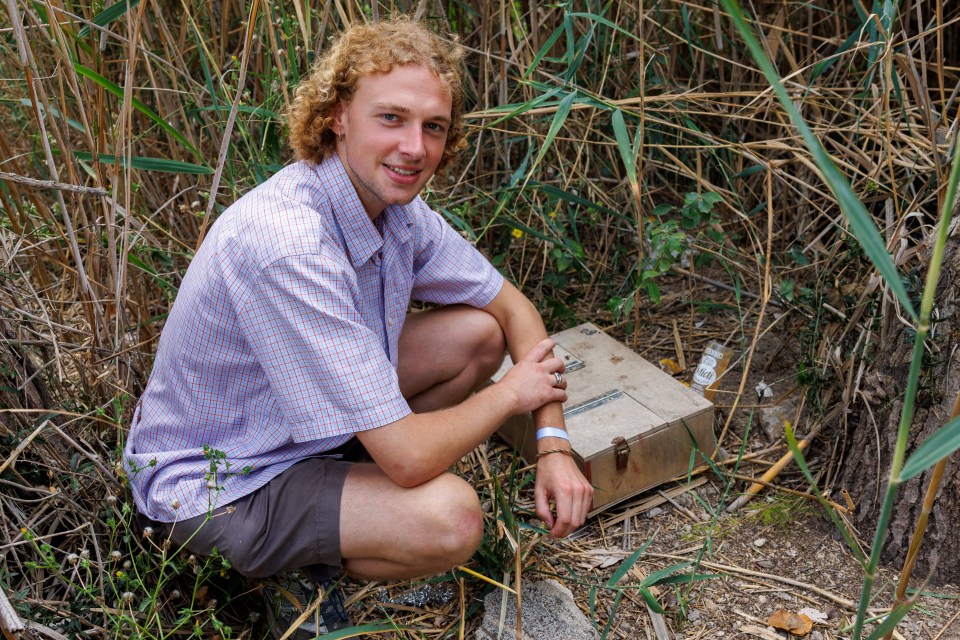AN army of snake hunters on a popular holiday island are battling an invasion of 7ft serpents.
The whopper reptiles – ballooning to more than twice their natural size – have got a stranglehold on the party island’s wildlife and left holidaymakers “too scared” to enter the sea.
News Group Newspapers LtdSun reporter Patrick Harrington with one of the snake traps being used to hunt the serpents taking over the island[/caption]
News Group Newspapers LtdA horseshoe whip snake caught in a trap in wetlands near Ibiza Town[/caption]
News Group Newspapers LtdPic Doug Seeburg – Inés Roig of Ibiza Preservation checks one of the snake traps in wetlands near Ibiza Town.[/caption]
Jam Press/Stephanie DaubA horseshoe snake left tourists too terrified to go in the sea off the coast of Ibiza[/caption]
Crack teams and activist locals have joined the battle against the destructive horseshoe whip snakes – which gorge on local animals.
Inés Roig, of Ibiza Preservation, is one of the islanders dedicated to trapping and removing the unwelcome colonisers.
The Sun joined Inés as she checked her snake traps in the Seis Feixes wetland near Ibiza town.
She told us: “The horseshoe snakes on Ibiza can grow up to two metres [seven foot] long, and can be as thick as an arm.
“On the mainland, they never grow to more than a metre.
“But the snakes in Ibiza have gigantism – meaning they grow much larger than they usually would.
“This is because they are invasive.
“There are no natural predators and many of the native reptiles and mammals are easy prey.”
Bathing holidaymakers have spotted the snakes slipping around the shallows alongside them at some of the most popular spots around the coast.
Inés said this is the first summer that the snake plague has been bad enough to impact tourists – and wildlife experts have been “shocked” to find the creatures now entering the water.
It means the snakes are reaching the smaller islets around Ibiza – and planting their flag there as well.
Ibiza Preservation snared almost 500 snakes last year using 280 traps and is expanding its programme.
Overall, hunters on the island captured a staggering 3,072 snakes in 2024.
The traps use a live mouse scurrying around one chamber as bait – which lures the snake into the next-door compartment.
But once it slithers in, the snake is trapped – and can’t get to the mouse either.
Instead, it will be scooped up by Inés or another wildlife officer and removed.
Trap-making kits are also being handed out for free to locals who want to join the fight and set up in their gardens.
News Group Newspapers LtdInés Roig of Ibiza Preservation, checking one of the snake traps[/caption]
News Group Newspapers LtdTraps on the island captured a staggering 3,072 snakes in 2024[/caption]
News Group Newspapers LtdThe wetlands near Ibiza town where snake hunters set traps[/caption]
Ibiza’s iconic wall lizards have suffered the most at the jaws of the snakes, along with small mammals and insects.
The shimmering lizards have taken a hammering after being gobbled up by the whip snakes – and lizard protection is the key aim of Ines’s programme.
Inés said: “You used to see them [the lizards] everywhere, all over Ibiza, but now they are much more rare.
“It’s very sad.”
Wall lizards have now been wiped out from 70 per cent of the island, according to El Pais.
Inés continued: “We need to cut the snake numbers as much as we can. Our focus is on preserving lizard numbers in areas of high biodiversity.
“I’ve heard in the news they are scaring the tourists and I know the locals don’t like them either – they are very thick and scary. Some are like anacondas.”
Horseshoe whip snakes arrived in Ibiza after they were stowed away inside a delivery of ornamental olive trees from the mainland.
They were first detected in 2003 – and in the past few years have run riot.
Orio Lapiedra, head of the Centre for Ecological Research and Forestry Applications, said: “They advance as if they were on the front of a battle zone.
“You have to imagine the snakes as if they were an actual wave, devouring what they find.”
The snakes aren’t venomous and don’t pose any serious threat to humans.
But Ines said she’s received nasty nips on her arms collecting snakes from traps.
Jordi Serapio, coordinator of the lizard protection programme, said: “Completely eliminating snake populations that have already become naturalised on the island for so many years is impossible.
“The current situation of the Ibiza wall lizard is very worrying.
“The fight against these invasive snakes is one of the most significant biodiversity conservation challenges that we are currently facing on the island.”
Why are snakes increasingly common across the Balearics?
Snakes are increasingly spotted in the Balearic Islands due to a combination of factors:
Ornamental olive trees imported from the mainland sometimes carry snake eggs hidden in the roots or soil
Warmer temperatures linked to climate change make the region more hospitable for reptiles, providing ideal conditions for snakes to thrive and reproduce
Habitat changes can disrupt local ecosystems, allowing snakes to spread more easily
A lack of natural predators on the islands means snakes can thrive with fewer threats
Growing tourism and trade can unintentionally introduce non-native species

